Gettysburg

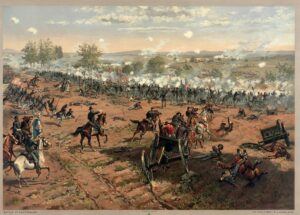 When things were heating up between the Confederate and Union soldiers around the town of Gettysburg on July 1, 1863, most of the town’s 2,400 civilian residents did their best to make themselves scarce. They didn’t want to find themselves pulled into the conflict on the basis of simply being in the vicinity when the Union needed reinforcements, so they did what they could to get out of the way…either staying shut up in their houses and basements or leaving for someplace calmer.
When things were heating up between the Confederate and Union soldiers around the town of Gettysburg on July 1, 1863, most of the town’s 2,400 civilian residents did their best to make themselves scarce. They didn’t want to find themselves pulled into the conflict on the basis of simply being in the vicinity when the Union needed reinforcements, so they did what they could to get out of the way…either staying shut up in their houses and basements or leaving for someplace calmer.
Not everyone felt that way, however. John Burns, who was about 69 years old at the time, although some said he was older, had fought a half-century earlier in the War of 1812. So, he was no stranger to war, but he took offence with the way a bunch of Rebels had come in and taken over his hometown. When he heard the sounds of battle on July 1, he told his wife he wanted to see what was going on. Grabbing his old flintlock musket, Burns left the house. He came across several Union officers and offered his services. The Union soldiers were basically amused by this strange character with his old musket, just showing up to offer to fight with them…and he wasn’t a young man, so that made it all the more strange. Still, Burns would not go away, and when he found a wounded soldier who would no longer need his rifle, Burns picked it up, and as the fighting heated up, Burns calmly took position behind a tree and began firing at the advancing Confederates. I guess the Union soldiers figured out pretty quickly that he meant business…especially when he was wounded three times in the intense fighting that day, and he still wouldn’t quit. One soldier recalled, “It must have been about noon when I saw a little old man coming up in the rear… I remember he wore a swallow-tailed coat with smooth brass buttons. He had a rifle on his shoulder. We boys began to poke fun at him as soon as he came amongst us, as we thought no civilian in his senses would [put] himself in such a place…”
The soldier then went on to say, “[When asked what] possessed him to come out there at such a time, he replied that ‘the rebels had either driven away or milked his cows, and that he was going to be even with them.’ About this time the enemy began to advance. Bullets were flying thicker and faster, and we hugged the ground about as close as we could. Burns got behind a tree and surprised us all by not taking a double-quick to the rear. He was as calm and collected as any veteran on the ground…I never saw John Burns after our movement to the right, when we left him behind his tree, and only know that he was true blue and grit to the backbone and fought until he was three times wounded.”
I’m sure it really upset the soldiers when they were forced to leave the injured Burns behind as they were ordered to retreat through the town. Burns was then found by the Confederates. Of course, since he had no uniform, they didn’t know that he wasn’t just a civilian who had been caught in the crossfire. Had they known he was fighting against them, they might have executed him, but a wise Burns had gotten rid of his weapon and pretended to be that helpless, unfortunate civilian who had been passing by at the wrong time. So, the Confederate surgeons treated him, and he was allowed to return home. The Confederates were none the wiser, and Burn had exacted his revenge. Burns was a happy man, because it just doesn’t get any better than that!!
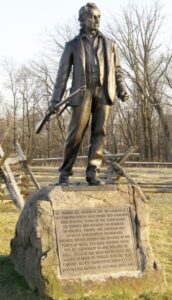
 So impressed were the Union soldiers with John Burns, that his story was told to their superiors, and Burns is now memorialized with a statue on the Gettysburg battlefield, and his valor was called out in an after-action report by Major General Abner Doubleday. The memorial reads: “My thanks are specially due to a citizen of Gettysburg named John Burns who although over 70 years of age shouldered his musket and offered his services to Colonel Wister, One Hundred and Fiftieth Pennsylvania Volunteers. Colonel Wister advised him to fight in the woods as there was more shelter there but he preferred to join our line of skirmishers in the open fields. When the troops retired he fought with the Iron Brigade. He was wounded in three places.” John Burns truly was a civilian hero, but the real moral of the story is “Don’t mess with the cows.”
So impressed were the Union soldiers with John Burns, that his story was told to their superiors, and Burns is now memorialized with a statue on the Gettysburg battlefield, and his valor was called out in an after-action report by Major General Abner Doubleday. The memorial reads: “My thanks are specially due to a citizen of Gettysburg named John Burns who although over 70 years of age shouldered his musket and offered his services to Colonel Wister, One Hundred and Fiftieth Pennsylvania Volunteers. Colonel Wister advised him to fight in the woods as there was more shelter there but he preferred to join our line of skirmishers in the open fields. When the troops retired he fought with the Iron Brigade. He was wounded in three places.” John Burns truly was a civilian hero, but the real moral of the story is “Don’t mess with the cows.”

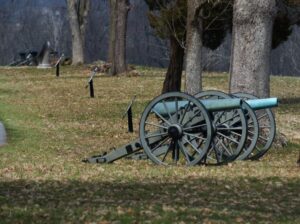 War is a really horrific thing for soldiers to go through, and closure comes in different forms for different soldiers. Returning to the battlefield is a way to find closure for many veterans. It is also a way for solders to keep the friendships they made at a time when their life depended on their fellow soldiers. Countless numbers of men have returned to places like the beaches of Normandy, France to see that place again, where so many lost their lives. Some soldiers didn’t leave the place they fought in their war. Vietnam was that way to a degree.
War is a really horrific thing for soldiers to go through, and closure comes in different forms for different soldiers. Returning to the battlefield is a way to find closure for many veterans. It is also a way for solders to keep the friendships they made at a time when their life depended on their fellow soldiers. Countless numbers of men have returned to places like the beaches of Normandy, France to see that place again, where so many lost their lives. Some soldiers didn’t leave the place they fought in their war. Vietnam was that way to a degree.
The Civil War was unique in that when the veterans decided to have their reunion, they wanted to, of course renew old friendships with those they shared a common bond, but they also wanted to make their reunion a way to bring the north and south back together again. The Gettysburg, Pennsylvania reunion was the largest of these events, and so made headline news around the world. The event took place in 1913 at Gettysburg, Pennsylvania. The Civil War was unique in that all participants were citizens of the United States. Brother fought against brother, and family members against family members. The reunion was a chance to repair those horribly broken relationships for all the men who were still alive at the reunion, which was held on the 50th anniversary of the battle. General H.S. Huidekoper, a Gettysburg Veteran of the 150th PA., was the man behind the idea of making it a gathering of both Northern and Southern Veterans on the 50th Anniversary of the battle. With the state of Pennsylvania, acting as host, $400,000 was set aside to finance the event. The Federal Government added $195,000 and the volunteer services of 1,500 officers and enlisted men. The event was five years in the planning, with Veteran groups throughout the nation helping to make it happen.
The Veterans who were still alive were aging, and because of the reunion, they were able not only to renew the friendships they had, but new friendships were born, and old wounds healed as well. The youngest Veteran, Colonel John C. Clem (known as the Shiloh drummer boy), was 62 years old. The oldest Veteran was 112 years of age. A total of 55,000 veterans attended the event, representing the half million living Confederate and Union Veterans. Of the 55,000 men, 22,103 came from Pennsylvania, and of those, 303 were Confederate. The smallest delegation came from New Mexico…one, a Union Veteran.
The event…one I wish I could have seen, saw over 5,000 tents, covering 280 acres in the middle of the battlefield, where so many had lost their lives. It was almost as if they were there too…giving their approval. Distinguished guests had come to give speeches and presentations. General Daniel Sickles, representing the III Corps at Gettysburg where he lost his leg, was the only corps commander present. On behalf of the battle leaders were the daughter of General Meade and the grandchildren of Generals Longstreet, A.P. Hill and Pickett.
The reunion lasted a full week. The men ate well and swapped stories, cried and laughed. In all 688,000 meals were served by two thousand cooks and helpers. Amazingly and considering the age and health of the Veterans, along with the hot, sultry weather, there were only nine Veterans who did not survive the week, a number well below the normal mortality rate for that day. Perhaps it was the exhilaration of the joining of old friends, reliving days of their youth, hearing the infamous Rebel Yell resound across the battlefield, or reenacting Pickett’s charge to have the Stars and Bars meet the trefoil of Hancock’s II Corps once more that had lengthened their lives.
In the most stunning moment of the event…on the fourth of July at high noon, a great silence fell over the battlefield, as the church bells began to toll. Buglers of the blue and gray prepared to play the mournful tune of Taps one last time. The guns of Gettysburg shook the ground, signaling the end of the weeklong event. When I visited Gettysburg many years later, I was surprised by exactly how that place felt. You could feel the atmosphere there all those years later. It is hallowed ground. You feel like you should whisper…or better yet just be silent. I have never felt that way before, or since.
And though many eloquent speeches were given at Gettysburg that week, none expressed what these Veterans took away from this experience better than a scene witnessed at the train station: “Nearly all of the men had said their good-byes and headed for home. On the station platform a former Union soldier from Oregon and a Louisiana Confederate were taking leave of each other. They shook hands and embraced, but neither seemed 
 able to find the words to express his feelings. Then an idea seemed to strike both men at once. In a simple act, which seemed to say everything they felt the pair took off their uniforms and exchanged them. The Yankee went home in Rebel gray, the Confederate in Union blue.” The above quote is an excerpt from “Gettysburg: The 50th Anniversary Encampment,” by Abbott M. Gibney, Civil War Times Illustrated, October 1970.
able to find the words to express his feelings. Then an idea seemed to strike both men at once. In a simple act, which seemed to say everything they felt the pair took off their uniforms and exchanged them. The Yankee went home in Rebel gray, the Confederate in Union blue.” The above quote is an excerpt from “Gettysburg: The 50th Anniversary Encampment,” by Abbott M. Gibney, Civil War Times Illustrated, October 1970.
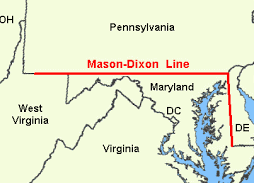
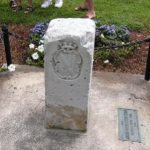 I think most of us have heard of the Mason-Dixon Line, but do we really know what it is and how it came to be called that? Maybe not. It was on October 18, 1767 that two surveyors, Charles Mason and Jeremiah Dixon completed their survey of the boundary between the colonies of Pennsylvania and Maryland, as well as areas that would eventually become the states of Delaware and West Virginia. The Penn and Calvert families had hired Mason and Dixon, two English surveyors, to settle their dispute over the boundary between their two proprietary colonies, Pennsylvania and Maryland. The dispute between the families often resulted in violence between the colonies’ settlers, the British crown demanded that the parties involved hold to an agreement reached in 1732. In 1760, as part of Maryland and Pennsylvania’s adherence to this royal command, Mason and Dixon were asked to determine the exact whereabouts of the boundary between the two colonies. Though both colonies claimed the area between the 39th and 40th parallel, what is now referred to as the Mason-Dixon line finally settled the boundary at a northern latitude of 39 degrees and 43 minutes. The line was marked using stones, with Pennsylvania’s crest on one side and Maryland’s on the other.
I think most of us have heard of the Mason-Dixon Line, but do we really know what it is and how it came to be called that? Maybe not. It was on October 18, 1767 that two surveyors, Charles Mason and Jeremiah Dixon completed their survey of the boundary between the colonies of Pennsylvania and Maryland, as well as areas that would eventually become the states of Delaware and West Virginia. The Penn and Calvert families had hired Mason and Dixon, two English surveyors, to settle their dispute over the boundary between their two proprietary colonies, Pennsylvania and Maryland. The dispute between the families often resulted in violence between the colonies’ settlers, the British crown demanded that the parties involved hold to an agreement reached in 1732. In 1760, as part of Maryland and Pennsylvania’s adherence to this royal command, Mason and Dixon were asked to determine the exact whereabouts of the boundary between the two colonies. Though both colonies claimed the area between the 39th and 40th parallel, what is now referred to as the Mason-Dixon line finally settled the boundary at a northern latitude of 39 degrees and 43 minutes. The line was marked using stones, with Pennsylvania’s crest on one side and Maryland’s on the other.
When Mason and Dixon began their endeavor in 1763, colonists were protesting the Proclamation of 1763, which was intended to prevent colonists from settling beyond the Appalachians and angering Native Americans. In reality, expansion was inevitable, but many in government couldn’t seem to see that. As the Mason and Dixon concluded their survey in 1767, the colonies were engaged in a dispute with the Parliament over the Townshend Acts, which were designed to raise revenue for the British empire by taxing common imports including tea. A protest that resulted in the Boston Tea Party, but that is another story. Twenty years later, in late 1700s, the states south of the Mason-Dixon line would begin arguing for the perpetuation of slavery in the new United States while those north of line hoped to phase out the ownership of human property. This period, which historians consider the era of “The New Republic,” drew to a close with the Missouri Compromise of 1820, which accepted the states south of the line as slave-holding and those north of the line as free. The compromise, along with those that followed it, eventually failed, and slavery was forbidden with the Emancipation Proclamation in 1862.
One hundred years after Mason and Dixon began their effort to chart the boundary, soldiers from opposite 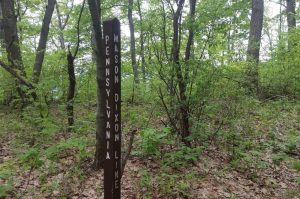
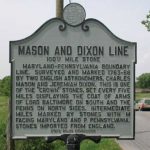 sides of the line spilled their blood on the fields of Gettysburg, Pennsylvania, in the Souths final and fatal attempt to breach the Mason-Dixon line during the Civil War. One hundred and one years after the Mason and Dixon completed their line, the United States finally admitted men of any complexion born within the nation to the rights of citizenship with the ratification of the 14th Amendment…a poorly thought out amendment which continues to cause illegal immigration to this day, due to birth right citizenship.
sides of the line spilled their blood on the fields of Gettysburg, Pennsylvania, in the Souths final and fatal attempt to breach the Mason-Dixon line during the Civil War. One hundred and one years after the Mason and Dixon completed their line, the United States finally admitted men of any complexion born within the nation to the rights of citizenship with the ratification of the 14th Amendment…a poorly thought out amendment which continues to cause illegal immigration to this day, due to birth right citizenship.
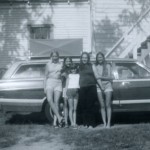 When my sister, Cheryl Masterson got married, and shortly after her then husband’s basic training, moved to Plattsburgh, New York, it marked a huge change in our family’s life. In fact, our family’s home life would never be the same again. Of course, we knew that having our sister get married and move out of the house was perfectly normal, but we were a close family, and somehow, we just weren’t prepared for that day. Of course, it was especially hard on my parents, and I can certainly understand that, since I have a daughter who lives far away now too, but in many ways, I think Cheryl’s move was harder on me than on my little sisters. Cheryl was the oldest, but she had always been a role model for me too. She had style and class, and I was at the very awkward age of fifteen. It seemed to me that she would be gone forever, and in the end, I was married before she came home, and I had my first daughter too. In many ways, we were both very different people by the time she returned. She was the mother of three children, and I had a daughter and one on the way. We were no longer the children we had been just a few short years before.
When my sister, Cheryl Masterson got married, and shortly after her then husband’s basic training, moved to Plattsburgh, New York, it marked a huge change in our family’s life. In fact, our family’s home life would never be the same again. Of course, we knew that having our sister get married and move out of the house was perfectly normal, but we were a close family, and somehow, we just weren’t prepared for that day. Of course, it was especially hard on my parents, and I can certainly understand that, since I have a daughter who lives far away now too, but in many ways, I think Cheryl’s move was harder on me than on my little sisters. Cheryl was the oldest, but she had always been a role model for me too. She had style and class, and I was at the very awkward age of fifteen. It seemed to me that she would be gone forever, and in the end, I was married before she came home, and I had my first daughter too. In many ways, we were both very different people by the time she returned. She was the mother of three children, and I had a daughter and one on the way. We were no longer the children we had been just a few short years before.
Of course, we saw Cheryl and her family during the time they lived in New York, in fact the family made two 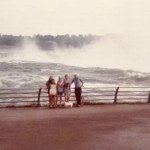 trips and I went up and spent Christmas and New Years the year after I graduated from high school. And the trips were wonderful…a great blessing to be sure. I suppose Mom and Dad might have taken us to the East Coast for a vacation sooner or later, because they did love to travel, but I might not have been still living at home when they did it, so I guess, for me, that this situation opened up doors that might not have been opened otherwise. Nevertheless, I think if we had been given the choice to have the trips to New York or Cheryl and her family living here, we would have taken the latter for sure. Be that as it may, our trips to New York allowed us to see the ocean, eat Maine Lobster, and see Niagara Falls. We saw Washington DC, Gettysburg, the bridges in Vermont, and many other sites up and down the East Coast. I suppose that looking back, we would have to admit that having Cheryl living in upstate New York, was in all reality, the opportunity of a lifetime…were it not for upstate New York being so very far away…that is.
trips and I went up and spent Christmas and New Years the year after I graduated from high school. And the trips were wonderful…a great blessing to be sure. I suppose Mom and Dad might have taken us to the East Coast for a vacation sooner or later, because they did love to travel, but I might not have been still living at home when they did it, so I guess, for me, that this situation opened up doors that might not have been opened otherwise. Nevertheless, I think if we had been given the choice to have the trips to New York or Cheryl and her family living here, we would have taken the latter for sure. Be that as it may, our trips to New York allowed us to see the ocean, eat Maine Lobster, and see Niagara Falls. We saw Washington DC, Gettysburg, the bridges in Vermont, and many other sites up and down the East Coast. I suppose that looking back, we would have to admit that having Cheryl living in upstate New York, was in all reality, the opportunity of a lifetime…were it not for upstate New York being so very far away…that is.
Those trips were a lot of fun, but they did not come even remotely close to having our family all together. And with each trip came the inevitable goodbyes and the parting tears. It felt like our hearts would just break…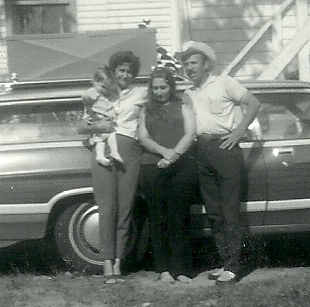 especially Mom and Dad, and poor Dad had to be the strong one all the way home with five weepy women in the car with him. He had to be the one to finally say, “We have to go. This is just too hard on everyone.” He had to do it because our sadness would have kept us there in tears for hours, if someone didn’t break us away. He had to be the strong one…because we sure couldn’t. Once Cheryl’s husband’s time in the service was over, they moved back to Casper, where she and her kids have lived ever since. Once the time was suddenly over, we could look back on it and it seemed to go by quite fast, but in the midst of it, that time felt like our world was falling apart. In reality, it was simply that we were no longer children, and life had taken the next logical step for us. I’m just glad that we are mostly closer to home now, with just a few exceptions.
especially Mom and Dad, and poor Dad had to be the strong one all the way home with five weepy women in the car with him. He had to be the one to finally say, “We have to go. This is just too hard on everyone.” He had to do it because our sadness would have kept us there in tears for hours, if someone didn’t break us away. He had to be the strong one…because we sure couldn’t. Once Cheryl’s husband’s time in the service was over, they moved back to Casper, where she and her kids have lived ever since. Once the time was suddenly over, we could look back on it and it seemed to go by quite fast, but in the midst of it, that time felt like our world was falling apart. In reality, it was simply that we were no longer children, and life had taken the next logical step for us. I’m just glad that we are mostly closer to home now, with just a few exceptions.
 When I first read about the six Knox brothers who were able to place themselves into a family history where they belonged, but in which no one had been able to connect them to before, I was intrigued, for sure. They seemed so resourceful, but I had a feeling that there was a lot more to them than just finding their place in the family history. I’m sure I will come back to these brothers over and over in the future, but when I read about Dr Nicholas C Knox, I was…well, amazed really. This man had the character and fortitude to overcome adversity, and move forward with his life, and in the end, make it better.
When I first read about the six Knox brothers who were able to place themselves into a family history where they belonged, but in which no one had been able to connect them to before, I was intrigued, for sure. They seemed so resourceful, but I had a feeling that there was a lot more to them than just finding their place in the family history. I’m sure I will come back to these brothers over and over in the future, but when I read about Dr Nicholas C Knox, I was…well, amazed really. This man had the character and fortitude to overcome adversity, and move forward with his life, and in the end, make it better.
The fourth son of Absalom Knox MD, Nicholas married Henrietta Craigan. After their marriage, the civil war slammed its way into the midst of their lives. Nicholas enlisted in the Seventeenth Mississippi Regiment, which was commanded by Colonel WS Featherstone, and was a part of McLaw’s Division. Nicholas took part in all the great battles in the Army of Virginia in which his command was engaged, but it was the Battle of Gettysburg that would change his life forever. On the second day of the battle, Nicholas lost his right arm. To make matter worse, he was captured and confined as a prisoner on Hart Island, off the city of New York, for several months before being parolled and sent into the Confederate lines again…without his right arm, and he managed to stay alive during the remainder of the battles he fought in.
During his entire enlistment time in the Civil War, Nicholas was never home…until the day he was discharged. I don’t know if he had been able to tell his wife about his arm, but even if he did, there is nothing like actually seeing it for the first time. It had to be hard for her…and for him. Many soldiers coming home from wars with life changing injuries feel very concerned about just how their spouse will look at them now. They feel like they are a lesser person than they were when they left, and that is just the physical challenges. I’m sure that an injury that cost you your arm, would be a moment that would live in your memory files for the rest of your life.
Nevertheless, Nicholas was not a man to let adversity take his life or his future from him. He returned to Mississippi, and he started the task of rebuilding his life, and getting reacquainted with his family. He started out by teaching school. Now most people would think that was a noble profession, and they would be right, but 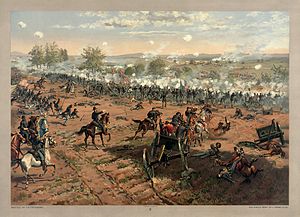 it was not enough for Nicholas. While teaching school, he began to study medicine, and received a diploma from a medical college at Nashville, Tennessee. When I think about the challenges of being a doctor in post Civil War America, with only one arm, and during a time when prosthetics were primitive at best, I am amazed. Still, Nicholas was not satisfied. He entered politics, and represented his county in the Legislature, and afterward was a practitioner of medicine in Reynolds, Mississippi, and he was an elder in the Presbyterian Church. No matter what challenges hit Nicholas, he met them head on, and succeeded in every endeavor he took on. He was not a man content to settle on the ordinary. He was truly an amazing man.
it was not enough for Nicholas. While teaching school, he began to study medicine, and received a diploma from a medical college at Nashville, Tennessee. When I think about the challenges of being a doctor in post Civil War America, with only one arm, and during a time when prosthetics were primitive at best, I am amazed. Still, Nicholas was not satisfied. He entered politics, and represented his county in the Legislature, and afterward was a practitioner of medicine in Reynolds, Mississippi, and he was an elder in the Presbyterian Church. No matter what challenges hit Nicholas, he met them head on, and succeeded in every endeavor he took on. He was not a man content to settle on the ordinary. He was truly an amazing man.
 My dad always loved teaching his family about the history of this great country. He and my mom decided early on that they wanted to show us the country we lived in, and they most certainly did. We traveled from one coast to the other, from the north to the south. Dad would stop at every historical marker he could find along the way. We would get tired of stopping at all the markers, but from that we learned about things like the Oregon Trail…a trail that I’m pretty sure I have seen every marker for…but one that I know all about too.
My dad always loved teaching his family about the history of this great country. He and my mom decided early on that they wanted to show us the country we lived in, and they most certainly did. We traveled from one coast to the other, from the north to the south. Dad would stop at every historical marker he could find along the way. We would get tired of stopping at all the markers, but from that we learned about things like the Oregon Trail…a trail that I’m pretty sure I have seen every marker for…but one that I know all about too.
He took us to Gettysburg, and we walked through the battlefield in hushed silence, because you can almost physically feel that this is hallowed ground…that the men who died there…who shed their blood to 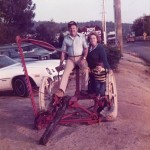 purchase freedom for all men…changed that place. Once you have been there and walked that place, you can never feel the same about a war that threatened to rip our country apart. And yet we remained, strong and determined.
purchase freedom for all men…changed that place. Once you have been there and walked that place, you can never feel the same about a war that threatened to rip our country apart. And yet we remained, strong and determined.
Dad told us about the old west, and the cost of settling this country. Families that traveled by covered wagon, westward to find a better life for their families, because there was room to grow out in the west. Room to farm and ranch and carve out a living that was unavailable in the east, which was much too crowded. The settlers were people who longed to find out what was over the next mountain top. Adventurers who wanted freedom to make their own rules.
He taught us about the gold rush in the Black Hills, and then showed us how so much 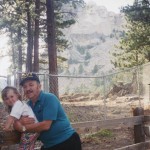 history still remains in the Black Hills. It became a place our family loved to go, and to this day Bob and I go over every year. It just has a hold on me…a draw that I can’t totally explain. I am always in awe there. The beauty of the hills, memorials, the 1880 train, and the old west shows in Keystone. I never get tired of being there.
history still remains in the Black Hills. It became a place our family loved to go, and to this day Bob and I go over every year. It just has a hold on me…a draw that I can’t totally explain. I am always in awe there. The beauty of the hills, memorials, the 1880 train, and the old west shows in Keystone. I never get tired of being there.
Dad and Mom took us and later our kids to so many places and showed us so many things. It is something we will always be grateful for, and that we can never thank them enough for. They gave us something no teacher or classroom could have taught us…they gave us a little piece of history.

